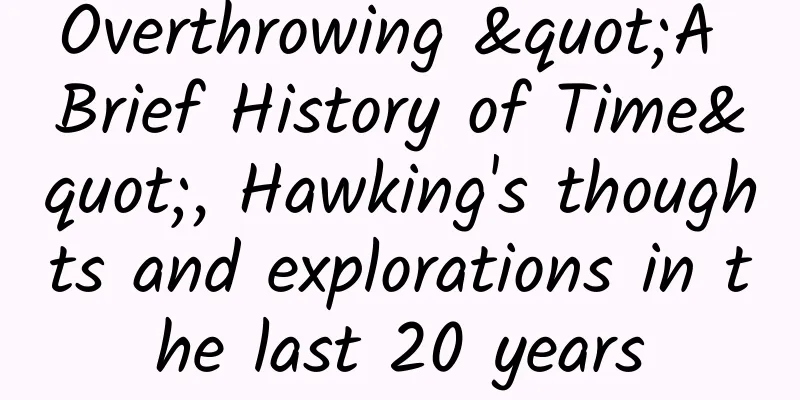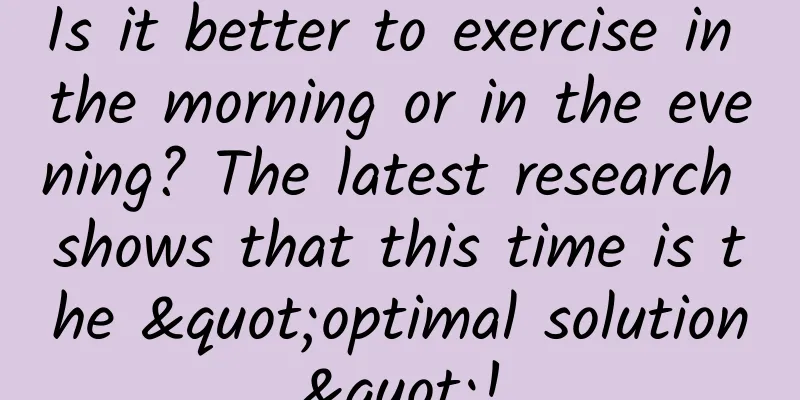Overthrowing "A Brief History of Time", Hawking's thoughts and explorations in the last 20 years

|
In his last paper published before his death, the famous British theoretical physicist Hawking proposed new concepts such as "new cosmology from top to bottom" and "cosmic hologram", which overturned the views on the origin of time put forward in "A Brief History of Time". Thomas Hertog, a Belgian cosmologist, is Hawking's disciple and co-author of this paper. In this article published in the Journal of High Energy Physics, Hawking and his viewpoint claim that there are not so many multiverses, and the evolution of the universe is smooth and finite as a whole. They came up with a revolutionary idea: the laws of physics are not immutable, but are born and co-evolve with the formation of the universe they govern, the so-called "top-down cosmology". After Hawking's death, Hertog completed the magnum opus that Hawking planned at the end of his life, forming the book "The Origin of Time", which attempts to reshape our overall concept of the evolution of the universe and life. The following is a book review written by Professor Wu Biao of Peking University for this book. Written by Wu Biao (Professor of the School of Physics, Peking University) The universe seems to be carefully designed for the existence of life. If the strong interaction in the nucleus deviates slightly from the actual situation, it will be difficult for nuclear fusion inside stars to produce carbon, which is the basis of life. In addition, space happens to be a very life-friendly three-dimensional space. The size of various physical parameters is just right. "Why is the universe like this?" Hawking asked Thomas Hertog this question when he was invited to Hawking's office for the first time in mid-June 1998. Since then, Hertog has begun to study quantum cosmology with Hawking to explore the origin of time. Let's try asking a smaller question: Why is there life on Earth? By comparing with other planets in the solar system, we find that the Earth is in just the right position and its mass is just right. By comparing with other stars in the Milky Way, we find that the size of the Sun is just right. It all seems to be carefully designed for the existence of life. Many people do think so: a supernatural master carefully designed the mass of the Sun, the mass of the Earth, and the relative distance between them to ensure that there is life on Earth. But science has now given a more reasonable explanation: there are many stars in the universe (conservatively estimated to be about 10^22), and these stars and their planets are different. It is very reasonable for there to be planets suitable for life. In fact, modern astronomical observations have discovered many planets suitable for life outside the solar system. If there are many different universes, it is not surprising that a few of them are suitable for life. This is the multiverse theory. Hawking is not satisfied with the multiverse theory, and it is not difficult to understand. We know that stars are formed by the gathering of interstellar dust under the influence of gravity. The distribution of dust is uneven, so stars of different sizes and their planets are formed. Compared with the formation of stars and planets, our understanding of the universe is very limited. According to the theory of inflation and the many-worlds theory, the multiverse is possible, but we don’t know how the universes in the multiverse are formed, and why different universes have different fundamental interactions. If we want to answer these questions thoroughly, we must know how to describe everything at the moment of the Big Bang. We have a general understanding of what happened after the Big Bang, but we still know nothing about the Big Bang itself. Hawking’s goal is to build a quantum theory of the Big Bang to tell us what happened before time and why our universe is so friendly to life. After that meeting in 1998, Thomas and Hawking began a journey together to explore the origin of the universe and time. Their exploration lasted about 20 years until Hawking died in 2018. Thomas visited Hawking on his deathbed and had a final conversation. Hawking said laboriously (through electronic devices): "It's time to write a new book..." So there was this "The Origin of Time", which records Hawking's thinking and exploration of the universe and time in the last 20 years of his life. Thomas's book vividly records Hawking's thoughts and explorations, and also describes the development of modern cosmology as background information, especially Lemaître's contribution to the Big Bang theory. Thomas introduces the physics and mathematics related to cosmology in a simple and easy-to-understand way, such as quantum interference, quantum measurement, many-worlds theory and superstring theory. His writing style is easy to understand, and he often uses analogies and diagrams to explain complex and subtle concepts more clearly. Hawking's short stories interspersed in the book allow readers to take a break from understanding the heavy cosmology. There are many theories about unifying gravity and quantum mechanics, but we don't know which one is right. Even all existing quantum gravity theories may be wrong, including the superstring theory supported by Hawking. This is because we do not have enough experimental data to verify these theories. For this reason, it is impossible for us to accurately describe the initial Big Bang of the universe, nor do we know how time emerged from it, and how the physical laws suitable for biological evolution were formed. However, this does not mean that we should give up exploration. We should continue to work hard and find the truth. Hawking did this. He knew that he might not find the answer, but he still firmly embarked on the road of exploration. He believed that "philosophy is dead" and that questions related to the origin of time are scientific questions, not philosophical questions. Scientists should bravely think and explore. Hawking did this in the last stage of his life, and his spirit, courage and wisdom will be remembered forever. He is a true role model who will inspire generations of scientists to move forward. Hawking believes that the universe started out without time. This conclusion may be correct regardless of the specific form of quantum gravity theory in the future. In physics, there are already similar phenomena. Macroscopic matter has volume, but the elementary particles that make up macroscopic matter, such as electrons and quarks, have no volume. The volume of macroscopic matter comes from the wave function of electrons in atoms, a quantum state of electrons. The ancient Chinese once said: "If you take half of a one-foot-long club every day, it will never run out." According to modern science, this is not true. If you take half every day, only molecules will be left after about a month; if you continue to do this, what will remain will be atoms, the club will no longer exist, and the volume will disappear. The lifespan of the universe is about 10^18 seconds. If the universe suddenly begins to collapse and becomes half younger every day, then after about 210 days, the universe will return to 10^(–44) seconds after the Big Bang, that is, the Planck time. At this time, time no longer exists, and what remains is only a certain quantum state of the universe at the beginning, just as the volume comes from the quantum state of electrons. According to the multiverse theory, the Planck time of different universes may be different, so 10^(–44) seconds may not be the smallest time. There are still too many unanswered questions about the universe, and we will continue Hawking's exploration. Thomas Hertog's "The Origin of Time" is a popular science book about the universe and time, recording Hawking's thoughts and explorations on these issues in the last stage of his life. The author uses easy-to-understand language to introduce various scientific fields related to cosmology, including quantum mechanics, black holes, string theory, etc., leading readers on an interesting scientific journey. For anyone who is interested in thinking about and exploring time and the universe, "The Origin of Time" is a very good read. It not only allows readers to understand the mysteries of the universe, but also inspires readers' interest and enthusiasm in science. Introduction to the author of "The Origin of Time" Thomas Hertog is a famous cosmologist, professor at the University of Leuven in Belgium and director of the Gravitational Wave Center. He has been a partner of Hawking for many years. His team in Belgium is mainly committed to studying the physical nature of gravitational waves and black holes based on string theory. In 2014, he received the European Research Council Independent Research Fund. In 2015, he received funding from the Flemish Scientific Research Fund. He and Hawking jointly published Hawking's last paper on the multiverse before his death. This book was also written on this basis and represents the final achievement of Hawking's scientific research career. Introduction to the translator of The Origin of Time Qiu Taotao , PhD in Theoretical Physics from the Institute of High Energy Physics, Chinese Academy of Sciences, postdoctoral researcher at Chung Yuan Christian University and National Taiwan University, and associate professor of the Department of Astronomy, School of Physics, Huazhong University of Science and Technology. He has been engaged in the research of cosmological theory for a long time, and his main research directions are inflation, rebound universe, modified gravity theory, primordial perturbation theory, dark energy, etc. Special Tips 1. Go to the "Featured Column" at the bottom of the menu of the "Fanpu" WeChat public account to read a series of popular science articles on different topics. 2. Fanpu provides a function to search articles by month. Follow the official account and reply with the four-digit year + month, such as "1903", to get the article index for March 2019, and so on. Copyright statement: Personal forwarding is welcome. Any form of media or organization is not allowed to reprint or excerpt without authorization. For reprint authorization, please contact the backstage of the "Fanpu" WeChat public account. |
<<: A world-class archaeological achievement! my country's first discovery in the South China Sea →
>>: What are the benefits of using mercury to make a liquid telescope?
Recommend
The "golden time" for breakfast and dinner is out! Eat before this time to stay away from many diseases!
"Is it best to finish breakfast before 9 o&#...
Tik Tok operation skills in the catering industry!
1. Current market situation of catering industry ...
The sales volume of new energy vehicles is expected to exceed 2 million this year, and Nezha ranks fourth after Wei, Xiaoli and Li Auto.
In recent years, driven by various factors, new e...
The General Administration has issued new regulations. Will there be any highlights in TV dramas in the future?
Since the implementation of the "Regulations...
The "health killer" that is more terrible than sugar and alcohol is hidden in the food you often eat
Now many people know the dangers of excessive sug...
Learn insurance sales from Zhang Weihua: 8 key points for efficient closing
Learn insurance sales from Zhang Weihua: 8 nodes ...
MoKee OpenSource 51.1 2015-07-25 Officially released!
MoKee OpenSource 51.1 2015-07-25 Official version...
Ant Financial is Alibaba's main weapon against Tencent
I have always believed that the outside world has...
How much does it cost to develop an underwear mini program in Panzhihua?
The launch of mini programs has brought convenien...
Huanghua SEO Training: What are the common sense issues in SEO? What are the difficulties in optimizing a website?
SEO, which stands for search engine marketing. Th...
5 Top Traffic Video Marketing and YouTube Video Production Tutorials
For many foreign trade people, video marketing is...
How do mini programs sell products? Which products are easier to sell in the mini program mall?
What products are good to sell in mini programs? ...
Burn My Calories: Why can’t I lose weight even though I exercise every day?
Many people rely on exercise to lose weight, but ...
Analysis of Pinduoduo's promotion system: attracting new customers and fission
As usual, let’s start by understanding Pinduoduo ...
![[Practical Information] Information flow advertising landing page treasured by people from all industries!](/upload/images/67cc24f9339c9.webp)








